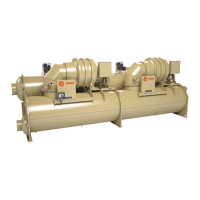104
CDHH-SVX003C-EN
Normal Operation
Table 24. Normal operation
Operating Characteristic Normal Reading
Approximate Evaporator Pressure 8 to 13.2 psia (55.2 to 91.0 kPaA) / -6.7 to -1.5 psig (-46.2 to -10.3 kPaG)
Approximate Condenser Pressure
(a)
24.2 to 37.7 psia (166.9 to 259.9 kPaA) / 9.5 to 23 psig (65.5 to 158.6 kPaG) (standard condenser)
Oil Sump Temperature Unit not running 110°F to 135°F (43.3°C to 57.2°C)
Oil Sump Temperature Unit running 110°F to 160°F (43.3°C to 71.1°C)
Oil Sump Differential Oil Pressure
(b)
20 to 24 psid (137.9 to 165.5 kPaD)
(a)
Condenser pressure is dependent on condenser water temperature, and should equal the saturation pressure of R-1233zd at a temperature above that of leaving condenser
water at full load.
(b)
Oil tank pressure: -7 to -4 psig (-48.3 to -27.6 kPaG). Discharge oil pressure: 13 to 20 psig (89.6 to 137.9 kPaG).
NOTICE
Equipment Damage!
Failure to remove the strain relief with the sensor
could result in equipment damage.
Do NOT attempt to pull sensor bulb through the strain
relief; always remove the entire strain relief with the
sensor.
Table 25. Recommended maintenance
Daily Every 3 months Every 6 months Annually
(a)
,
(b)
Check the chiller’s evaporator and
condenser pressures, oil tank
pressure, differential oil pressure, and
discharge oil pressure. Compare the
readings with the values provided in
the preceding table.
Check the oil level in the chiller oil
sump using the two sight glasses
provided in the oil sump head. When
the unit is operating, the oil level
should be visible in the lower sight
glass.
Complete logs on a daily basis.
Clean all water strainers in the water
piping system.
Lubricate the vane control linkage
bearings, ball joints, and pivot points.
Lubricate vane operator tang O-rings.
Operate the tang operators manually
and check for any abnormalities.
Drain contents of the rupture disk and
purge discharge vent-line drip-leg into
an evacuated waste container. Do this
more often if the purge is operated
excessively. Apply oil to any exposed
metal parts to prevent rust.
Shutdown the chiller once each year to check the items
listed on the “Appendix D: CenTraVac™ Chiller Annual
Inspection List,” p. 120 (refer to “Appendix A: Forms
and Check Sheets,” p. 115).
Perform the annual maintenance procedures referred to
in “Maintenance,” p. 108.
Use an ice water bath to verify the accuracy of the
evaporator refrigerant temperature sensor (4BT11). If
the sensor is exposed to temperature extremes outside
its normal operating range (0°F to 90°F [-17.8°C to
32.2°C]), check its accuracy at six-month intervals.
Inspect the condenser tubes for fouling; clean if
necessary.
Recommended Maintenance

